|
Graphene...
and the coming Robotnik quantum brain
Capt Wardrobe / Thirteenth Monkey - July 2021
|
|
|
Graphene...
and the coming Robotnik quantum brain
Capt Wardrobe / Thirteenth Monkey - July 2021
|
|
|
from this
to this
|
Graphene's unique properties have engendered high expectations in a host of areas, including for advanced composites and new types of electronic devices.
While graphene can come in many forms, its purest form is that of a one-atom-thick layer of graphite. This structure has provided the highest thermal conductivity ever recorded 1 - 0 times higher than copper. It also has one of the highest intrinsic electron mobilities of any material (the speed at which electrons can travel through a material), which is approximately 100 times greater than silicon - a tantalizing property for electronic applications.
IEEE.org
Energy harvested from the device owner
You could be the source of power for your next device, if research into TENGs comes to fruition. A TENG - or triboelectric nanogenerator - is a power harvesting technology which captures the electric current generated through contact of two materials.
A research team at Surrey's Advanced Technology Institute and the University of Surrey have given an insight into how this technology might be put into place to power things like wearable devices. While we're some way from seeing it in action, the research should give designers the tools they need to effectively understand and optimise future TENG implementation.
|
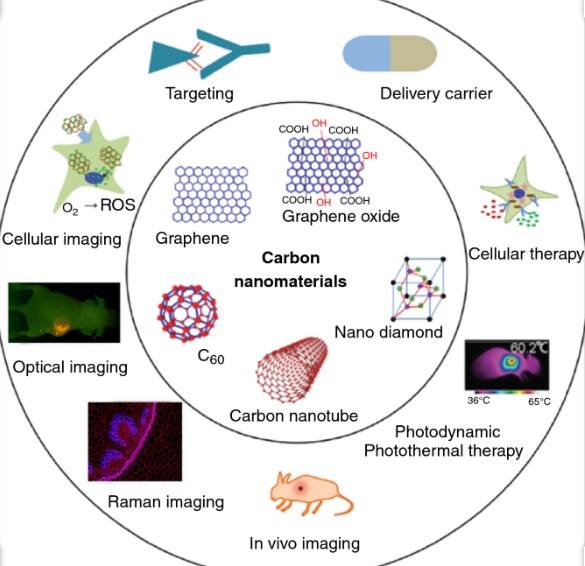
|
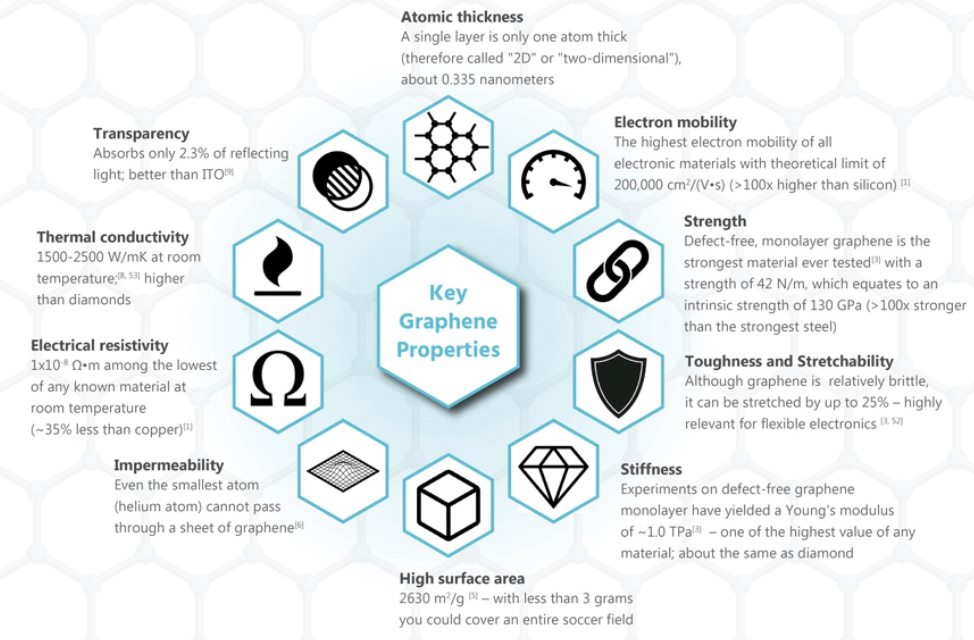
|
How is it made?
where does it come from?
|
The Graphene Council has a team of global experts, from academia and industry, to help you identify the right material and application development partners. No one knows more about graphene commercialization. Work with the experts that are part of the world's largest network of graphene researchers and commercial professionals. The Graphene council |
Around the world, research institutions are trying to develop ways to revolutionise the production of graphene sheets of the highest quality. One of the most cost effective ways this is possible is by the reduction of graphene oxide into rGO (reduced graphene oxide). The problem with this technique is the quality of graphene sheets produced, which (with certain methods) displays properties currently below the theoretical potential of pristine graphene compared to other methods such as mechanical exfoliation. However, this doesn't mean that improvements can’t be made, or that this reduced graphene oxide is effectively unusable; far from it, in fact.
Graphite Oxide
Graphite oxide is a compound made up of carbon, hydrogen and oxygen molecules. It is artificially created by treating graphite with strong oxidisers such as sulphuric acid. These oxidisers work by reacting with the graphite and removing an electron in the chemical reaction. This reaction is known as a redox (a portmanteau of reduction and oxidisation) reaction, as the oxidising agent is reduced and the reactant is oxidised.
|
The most common method for creating graphite oxide in the past has been the Hummers and Offeman method, in which graphite is treated with a mixture of sulphuric acid, sodium nitrate and potassium permanganate (a very strong oxidiser). However, other methods have been developed recently that are reported to be more efficient, reaching levels of 70% oxidisation, by using increased quantities of potassium permanganate, and adding phosphoric acid combined with the sulphuric acid, instead of adding sodium nitrate.
Graphene oxide is effectively a by-product of this oxidisation as when the oxidising agents react with graphite, the interplanar spacing between the layers of graphite is increased. The completely oxidised compound can then be dispersed in a base solution such as water, and graphene oxide is then produced.
Graphite oxide and graphene oxide are very similar, chemically, but structurally, they are very different. The main difference between graphite oxide and graphene oxide is the interplanar spacing between the individual atomic layers of the compounds, caused by water intercalation. This increased spacing, caused by the oxidisation process, also disrupts the sp2 bonding network, meaning that both graphite oxide and graphene oxide are often described as electrical insulators.
Graphite Oxide to Graphene Oxide
The process of turning graphite oxide into graphene oxide can ultimately be very damaging to the individual graphene layers, which has further consequences when reducing the compound further (explanation to follow). The oxidisation process from graphite to graphite oxide already damages individual graphene platelets, reducing their mean size, so further damage is undesirable. Graphene oxide contains flakes of monolayer and few layer graphene, interspersed with water (depending on the base media, the platelet to platelet interactions can be weakened by surface functionality, leading to improved hydrophilicity).
In order to turn graphite oxide into graphene oxide, a few methods are possible. The most common techniques are by using sonication, stirring, or a combination of the two. Sonication can be a very time-efficient way of exfoliating graphite oxide, and it is extremely successful at exfoliating graphene (almost to levels of full exfoliation), but it can also heavily damage the graphene flakes, reducing them in surface size from microns to nanometres, and also produces a wide variety of graphene platelet sizes. Mechanically stirring is a much less heavy-handed approach, but can take much longer to accomplish.
"Where scientific engineers need to utilize large quantities of graphene for industrial applications such as energy storage, rGO is the most obvious solution"
|
|
Graphene Oxide to Reduced Graphene Oxide
Reducing graphene oxide to produce reduced graphene oxide (hitherto referred to as rGO), is an extremely vital process as it has a large impact on the quality of the rGO produced, and therefore will determine how close rGO will come, in terms of structure, to pristine graphene. In large scale operations where scientific engineers need to utilize large quantities of graphene for industrial applications such as energy storage, rGO is the most obvious solution, due to the relative ease in creating sufficient quantities of graphene to desired quality levels.
As you would expect, there are a number of ways reduction can be achieved, though they are all methods based on chemical, thermal or electrochemical means. Some of these techniques are able to produce very high quality rGO, similar to pristine graphene, but can be complex or time consuming to carry out.
In the past, scientists have created rGO from GO by:
Treating GO with hydrazine hydrate and maintaining the solution at 100 for 24 hours
Exposing GO to hydrogen plasma for a few seconds
Exposing GO to another form of strong pulse light, such as those produced by xenon flashtubes
Heating GO in distilled water at varying degrees for different lengths of time
|
|
|
Graphite... Essential Non-metallic mineral needs to be mined & processed, like coal. sustainable? green? hey wait a minute!
Graphite is one of the most essential non-metallic minerals, with a wide variety of applications. Its physical-chemical properties and its high resistance to heat make it an excellent thermal and electrical conductor. It is used in steel manufacturing and for coating the foundry moulds of the metal industry; engine parts, mechanical seals, anti-corrosive paint, lithium-ion and alkaline batteries, small electronic devices such as smartphones, electrical cars are the major industry branches that consume graphite minerals. Graphite is listed as one of the critical raw materials for the European Union (EU).
Graphite is a natural form of carbon (C) and is characterised by hexagonal tabular lattice layers. Thermal conductivity is anisotropic, very high in the direction parallel to the plane of the layers and low in the perpendicular direction. It is soft, flexible and sectile but not elastic. Commercial sources of natural graphite are commonly classified as flake, vein or amorphous.
|
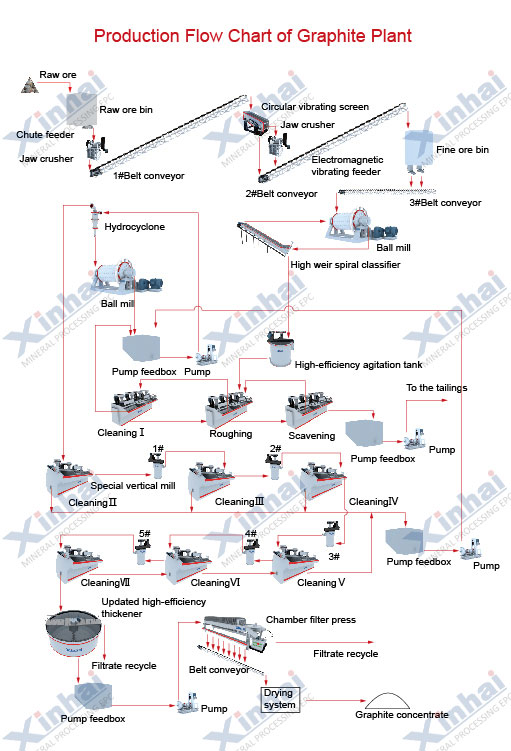
|
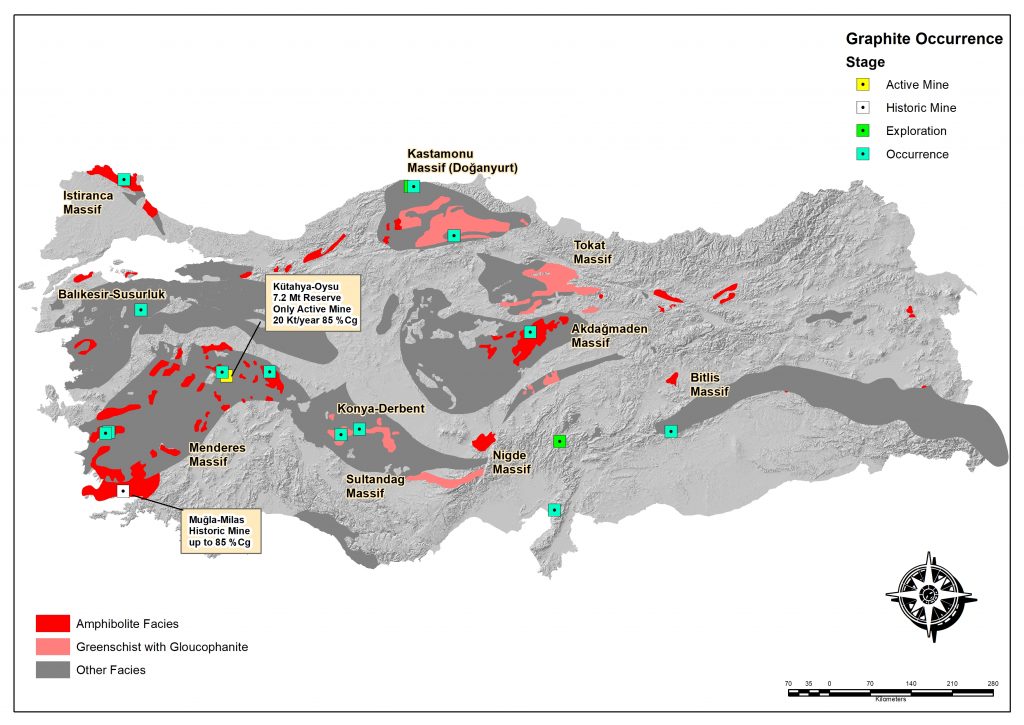
|
Flake graphite is associated mostly with high-grade metamorphic rocks where organic carbon deposited within sediments was transformed into graphite by pressure typically exceeding 5 kilobar and temperatures above 700 °C. Graphite-bearing rocks include orthoquartzite and marble, but more commonly are quartz–biotite schist and gneiss. The graphite is often present as flakes or elongated patches aligned with the schistosity or banding to form lenses. High purity flake graphite can be produced by flotation without chemical purification. Flakes are flexible and can be rolled into very small potato shapes for use in battery anodes. Product grades change between 85-97 %Cg (total carbon grade in graphite form).
Vein graphite occurs as fracture-fill vein or pipe-like bodies where graphitic carbon and/or carbon-rich fluids have migrated and precipitated as graphite masses. High-grade, vein-style graphite is known of in several countries, but at present is produced only in Sri Lanka. Product grades range between 90-99 %Cg.
|
|
Amorphous graphite is produced mostly from anthracitic coal seams that have undergone variable graphitisation during contact or high pressurised regional metamorphism. This form of graphite is typically massive and has comparatively high levels of fine-grained impurities that are not easily separable from the graphite. Commercial grades typically range from 75% to 85 %Cg. Synthetic graphite is made by heating amorphous carbon materials, such as calcined petroleum coke of suitable crystalline quality, in a reducing environment at temperatures between 2,300 and 3,000 °C to convert it to graphite.
In the economic evaluation of graphite deposits, the following factors are important: a) type, size, grade and tonnage of the ore bodies, and b) the grain size and distribution of the graphite flakes in the ores. Commercial graphite is a relatively expensive industrial mineral and to obtain good quality graphite concentrates, beneficiation is essential.
|
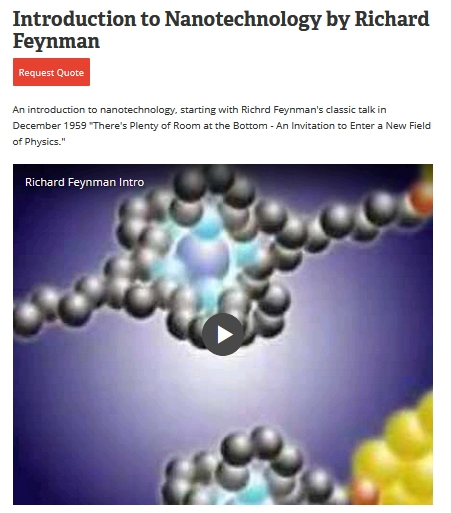 click on pic for source |
What is nano technology? Hear it from the major players in it's inception - Dr Richard Feynman
& K Erik Drexler Nanosystems: Molecular Machinery, Manufacturing, and Computation |
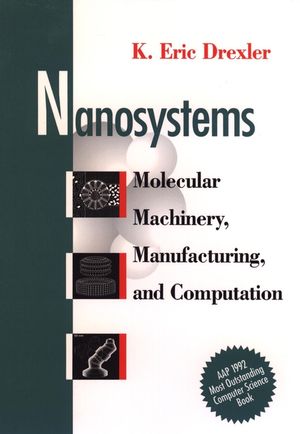
|
|
The Concept of Bio-electro magnatism
|


The effects of mind, emotional support systems, stress management, the placebo effect, and other subtle factors affecting health have been long noted and documented. The missing ingredient for serious clinical study within mainstream science of such effects has been the absence of a cause-and-effect link within the accepted scientic and medical paradigm. Electromagnetic and quantum effects, operating below the scale of chemical description have now become recognized as fertile ground for understanding these subtle linkages. The experimental bioelectric evidence reported by Tiller in this publication represent a significant advance in probing the linkage to mind of this level of bioelectromagnetic activity. In this chapter a related and interacting phenomenon is reported. Off-axis electron holography, liquid cell TEM, magnetic nanoparticles, magnetotactic bacteria
see also
Off-axis electron holography of bacterial cells and magnetic
nanoparticles in liquid
|
|
Graphene materials and their biological interactions.
(A) A parameter space for the most widely used graphene materials can be described by the dimensions and surface functionalization of the material, the latter defined as the percentage of the carbon atoms in sp3 hybridization. Green squares represent epitaxially grown graphene; yellow, mechanically exfoliated graphene; red, chemically exfoliated graphene; blue, graphene oxide. Note that a number of other graphene-related materials (such as graphene quantum dots and graphene nanoribbons) are also being used in experiments.
(B) Possible interactions between graphene-related materials with cells (the graphene flakes are not to scale).
(a) Adhesion onto the outer surface of the cell membrane.
(b) Incorporation in between the monolayers of the plasma membrane lipid bilayer.
(c) Translocation of membrane.
(d) Cytoplasmic internalization.
(e) Clathrin-mediated endocytosis.
(f) Endosomal or phagosomal internalization.
(g) Lysosomal or other perinuclear compartment localization.
(h) Exosomal localization.
The biological outcomes from such interactions can be considered to be either adverse or beneficial, depending on the context of the particular biomedical application. Different graphene-related materials will have different preferential mechanisms of interaction with cells and tissues that largely await discovery.
|
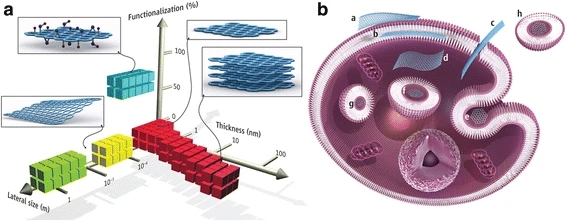
Protein corona effect
Because of the high free surface charge, nanomaterials can easily form “coronas” with proteins in biological systems [163, 164]. The protein corona is suggested to affect the circulation, distribution, clearance and toxicity of nanoparticles. Several papers reported that GO forms GO-protein coronas with adsorbed plasma proteins in serum and these GO-protein coronas play an important role in deciding the fate of the GO biokinetic behaviour in vivo. Such GO-protein coronas can regulate the adhesion of GO to endothelial and immune cells through both specific and nonspecific interactions.
particleandfibretoxicology.biomedcentral.com
The family of coronavirus are named for their crown shape. Encoded by the genetic material inherited from the coronavirus itself, this intrinsic well-known “viral corona” is considered an “inherited corona”. After contact with mucosa or the entrance into the host, bare coronaviruses can become covered by a group of dissolved biomolecules to form one or multiple layers of biomolecules. The layers acquired from the surrounding environment are named the “acquired corona”. We highlight here the possible role of the acquired corona in the pathogenesis of coronaviruses, which will generate fresh insight into the nature of various coronavirus-host interactions.
|

[above]The formation of acquired corona in different environmental compartments.
Schematic diagram [right] shows the possible mechanisms of GFNs cytotoxicity. GFNs get into cells through different ways, which induce in ROS generation, LDH and MDA increase, and Ca2+ release. Subsequently, GFNs cause kinds of cell injury, for instance, cell membrane damage, inflammation, DNA damage, mitochondrial disorders, apoptosis or necrosis
|
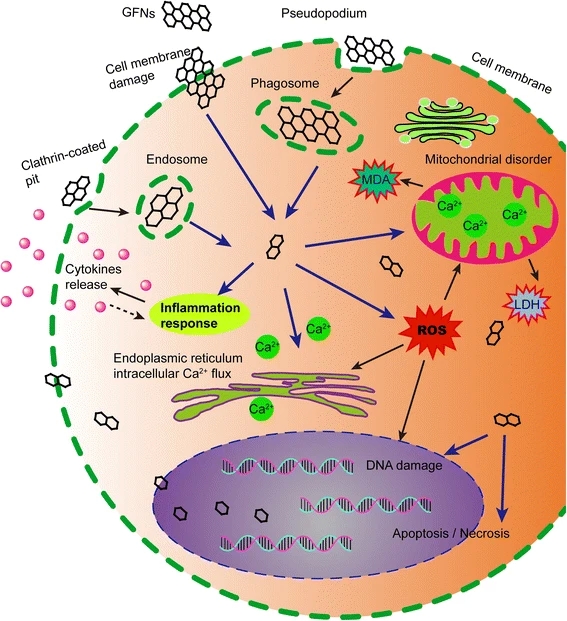
|
|
Graphene-based sensors used for human health monitoring
Since the desire for real-time human health monitoring as well as seamless human-machine interaction is increasing rapidly, plenty of research efforts have been made to investigate wearable sensors and implantable devices in recent years.
As a novel 2D material, graphene has aroused a boom in the field of sensor research around the world due to its advantages in mechanical, thermal, and electrical properties.
Numerous graphene-based sensors used for human health monitoring have been reported, including wearable sensors, as well as implantable devices, which can realize the real-time measurement of body temperature, heart rate, pulse oxygenation, respiration rate, blood pressure, blood glucose, electrocardiogram signal, electromyogram signal, and electroencephalograph signal, etc.
Herein, as a review of the latest graphene-based sensors for health monitoring, their novel structures, sensing mechanisms, technological innovations, components for sensor systems and potential challenges will be discussed and outlined.
|
|
About ZEN Graphene Solutions Ltd.
ZEN is a next-gen nanomaterials technology company developing and commercializing technologies that help protect people and the environment. ZEN is currently focused on commercializing ZENGuardTM, a patent pending graphene-based coating with 99% antimicrobial activity, including against COVID-19, and the potential to use similar graphene compounds as pharmaceutical products against infectious diseases.
The company has a significant R&D pipeline with an interest in monomers, polymers, metal alloys, corrosion coatings, biosensors along with the production of graphene oxide and graphene quantum dots.
Additionally, the company owns the unique Albany Graphite Project which provides the company with a potential competitive advantage in the graphene market. Labs in Japan, UK, Israel, USA, and Canada have independently demonstrated that ZEN’s Albany PureTM Graphite is an ideal precursor material that easily converts (exfoliates) to graphene, using a variety of mechanical, chemical, and electrochemical methods.
|
|
Nanomedicine: A Diagnostic and Therapeutic Approach to COVID-19
The SARS-CoV-2 virus is causing devastating morbidity and mortality worldwide. Nanomedicine approaches have a high potential to enhance conventional diagnostics, drugs and vaccines.
In fact, lipid nanoparticle/mRNA vaccines are already widely used to protect from COVID-19.
In this review, we present an overview of the taxonomy, structure, variants of concern, epidemiology, pathophysiology and detection methods of SARS-CoV-2.
The efforts of repurposing, tailoring, and adapting pre-existing medications to battle COVID-19 and the state of vaccine developments are presented.
Next, we discuss the broad concepts and limitations of how nanomedicine could address the COVID-19 threat. Nanomaterials are particles in the nanometer scale (10–100 nm) which possess unique properties related to their size, polarity, structural and chemical composition.
Nanoparticles can be composed of precious metals (copper, silver, gold), inorganic materials (graphene, silicon), proteins, carbohydrates, lipids, RNA/DNA, or conjugates, combinations and polymers of all of the aforementioned. The advanced biochemical features of these nanoscale particles allow them to directly interact with virions and irreversibly disrupt their structure, which can render a virus incapable of replicating within the host.
Virus-neutralizing coats and surfaces impregnated with nanomaterials can enhance personal protective equipment, hand sanitizers and air filter systems. Nanoparticles can enhance drug-based therapies by optimizing uptake, stability, target cell-specific delivery, and magnetic properties.
In fact, recent studies have highlighted the potential of nanoparticles in different aspects of the fight against SARS-CoV-2, such as enhancing biosensors and diagnostic tests, drug therapies, designing new delivery mechanisms, and optimizing vaccines. This article summarizes the ongoing research on diagnostic strategies, treatments, and vaccines for COVID-19, while emphasizing the potential of nanoparticle-based pharmaceuticals and vaccines.
|

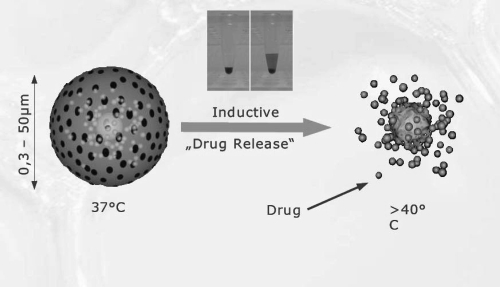
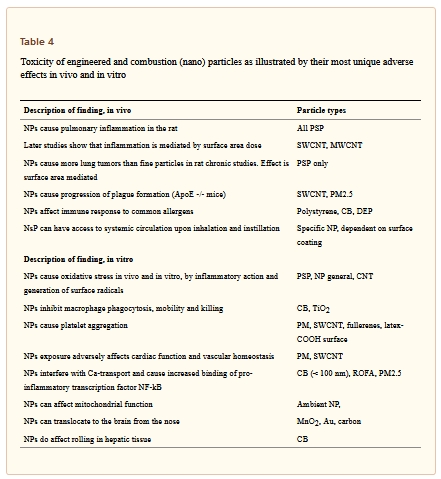
|
from 2008 -
The Brain –
From several perspectives the brain is a challenging organ for drug delivery. First, the incidence of degenerative diseases in the brain will increase with the aging population. Secondly, the blood brain barrier (BBB) is well-known as the best gatekeeper in the body toward exogenous substances (review Pardridge 2007). Generally pharmaceuticals including most small molecules do not cross the BBB. The endothelial barrier is specifically tight at the interface with the brain astrocytes and can in normal conditions only be passed using endogeneous BBB transporters resulting in carrier mediated transport, active efflux transport and/or receptor mediated transport. However the barrier properties may be compromised intentionally or unintentionally by drug treatment allowing passage of nanoparticles (Olivier et al 1999; Kreuter et al 2003; Lockman et al 2003; Koziara et al 2006). The delivery of drugs by nanocarrier was recently reviewed (Koziara et al 2006; Tiwari and Amiji 2006).
Passage of the BBB was suggested to be possible by the toxic effect of nanoparticles (about 200 nm) on cerebral endothelial cells (Olivier et al 1999), although for similar nanoparticles (about 300 nm) this was contradicted in another study (Kreuter et al 2003). In addition this effect was not found for a different type of nanoparticles (Lockman et al 2003). Physical association of the drug to the nanoparticles was necessary for drug delivery to occur into the brain (Kreuter et al 2003). When nanoparticles with different surface characteristics were evaluated, neutral nanoparticles and low concentrations of anionic nanoparticles were found to have no effect on BBB integrity, whereas high concentrations of anionic nanoparticles and cationic nanoparticles were toxic for the BBB. The extent of brain uptake of anionic nanoparticles at lower concentrations was superior to neutral or cationic formulations at the same concentrations. So, nanoparticle surface charges must be considered for toxicity and brain distribution profiles (Lockman et al 2004). Especially coating of the nanoparticles with the polysorbate (Tween) surfactants resulted in transport of drugs across the blood brain barrier (Kreuter 2004). The mechanism for transport was suggested to be endocytosis via the Low Density Lipoprotein (LDL) receptor of the endothelial cells after adsorption of lipoproteins form blood plasma to the nanoparticles (Kreuter 2001, 2004). Additional investigations revealed the role of apolipoprotein-E for transport of drugs across the BBB while apolipoprotein-E variants that did not recognized lipoprotein receptors failed in transporting the drug across the BBB (Michaelis et al 2006). It was suggested that the recognition and interaction with lipoprotein receptors on brain capillary endothelial cells was responsible for the brain uptake of the drug.
Passage of the BBB may also be achieved by masking certain drug characteristics preventing or limiting binding to cellular efflux systems like p-glycoprotein, a cellular transporter associated with drug removal from cells. P-glycoprotein is one of the ATP dependent efflux transporters that has an important physiological role in limiting drug entry into the brain (Girardin 2006; Sharom 2006). In addition, p-glycoprotein also designated the multidrug resistance protein may be highly expressed in drug resistant tumor cells. Surfactant coated poly(butyl) cyanoacrylate nanoparticles have been used to deliver drugs to the CNS (Alyautdin et al 1997) The effect of entrapment of a cytotoxic drug paclitaxel (PX) in cetyl alcohol/polysorbate nanoparticles (PX NP) was evaluated in an in situ rat brain perfusion model (Koziara et al 2004). The results suggest that entrapment of paclitaxel in nanoparticles significantly increases the brain drug uptake and its toxicity towards p-glycoprotein expressing tumor cells (p-glycoprotein is an efflux transporter associated with drug removal from the cells). It was hypothesized that PX nanoparticles limit paclitaxel binding to p-glycoprotein and subsequent efflux from the cells, which consequently would lead to higher brain and tumor cell levels.
Other routes for reaching the brain, circumventing the BBB, may be via migration along the olfactory or trigeminal nerve endings after deposition on the olfactory mucosa in the nasal region (Oberdörster et al 2004). Translocation of ultrafine 13C particles (35 nm) was detected by using this isotope measurement in the brain olfactory bulb after inhalation exposure. Also other solid NP like manganese oxide was shown to translocate to the brain by the olfactory route (Elder et al 2006), based on measurements of manganese in different parts of the brain. In order to increase the specific uptake via the inhalation route nanoparticles have been functionalized by conjugation with bioactive ligands-lectins to the surface of poly (ethylene glycol)- poly (lactid acid) (PEG-PLA) nanoparticles. Wheat germ agglutinin (WGA) was used which binds to N-acetyl-D-glucosamine and sialic acid both of which are abundantly present in the nasal cavity. There was a twofold increase in the brain uptake of such functionalized NP (Gao et al 2006). However, it needs to be stated that both passage of the BBB and the olfactory route only account for up to 2% nanoparticles uptake, and its efficacy with regard to drug delivery needs to make considerable increments before use.
|
| The use of Nanotechnology in medicine and more specifically drug delivery is set to spread rapidly. For decades pharmaceutical sciences have been using nanoparticles to reduce toxicity and side effects of drugs. Up to recently it was not realized that these carrier systems themselves may impose risks to the patient. The type of hazards that are introduced by using nanoparticles for drug delivery are beyond that posed by conventional hazards imposed by chemicals in delivery matrices. However, so far, the scientific paradigm for the possible (adverse) reactivity of nanoparticles is lacking and we have little understanding of the basics of the interaction of nanoparticles with living cells, organs and organisms. A conceptual understanding of biological responses to nanomaterials is needed to develop and apply safe nanomaterials in drug delivery in the future. |
|
Graphene Oxide Nanosheets Interact and Interfere with SARS-CoV-2
14th May 2021 -
Abstract
Nanotechnology can offer a number of options against coronavirus disease 2019 (COVID-19) acting both extracellularly and intracellularly to the host cells.
Here, the aim is to explore graphene oxide (GO), the most studied 2D nanomaterial in biomedical applications, as a nanoscale platform for interaction with SARS-CoV-2. Molecular docking analyses of GO sheets on interaction with three different structures: SARS-CoV-2 viral spike (open state – 6VYB or closed state – 6VXX), ACE2 (1R42), and the ACE2-bound spike complex (6M0J) are performed. GO shows high affinity for the surface of all three structures (6M0J, 6VYB and 6VXX). When binding affinities and involved bonding types are compared, GO interacts more strongly with the spike or ACE2, compared to 6M0J. Infection experiments using infectious viral particles from four different clades as classified by Global Initiative on Sharing all Influenza Data (GISAID), are performed for validation purposes. Thin, biological-grade GO nanoscale (few hundred nanometers in lateral dimension) sheets are able to significantly reduce copies for three different viral clades. This data has demonstrated that GO sheets have the capacity to interact with SARS-CoV-2 surface components and disrupt infectivity even in the presence of any mutations on the viral spike. GO nanosheets are proposed to be further explored as a nanoscale platform for development of antiviral strategies against COVID-19. |
|
What's all this about Nano-Magnetics?
Amazing Polly asks questions about the strange internet sensation of magnetic skin surfaces as vaccine adverse reactions, delving into nano particals into the history of the Bio-Research & possible signs of nano materials in Healthcare PPP - cotton buds & masks
Left is a comparison she made with the PCR swabbing procedure and the location of the endorhinal cortex...the major pathway enabling blood brain barrier entry for nano-neuro Mind control.
note: COVFEFE?
Has Amazing Polly finally decoded COVFEFE?
COV (covid/coronavirus)
graphene-mediated (FeFe)
|
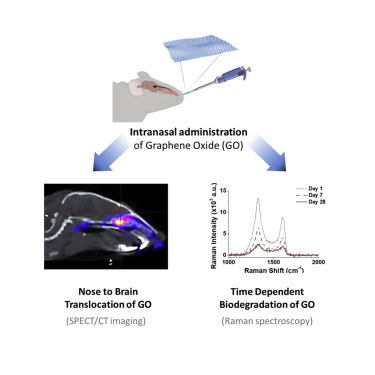 |
|
Brain-accumulated graphene oxide undergoes changes consistent with biodegradation
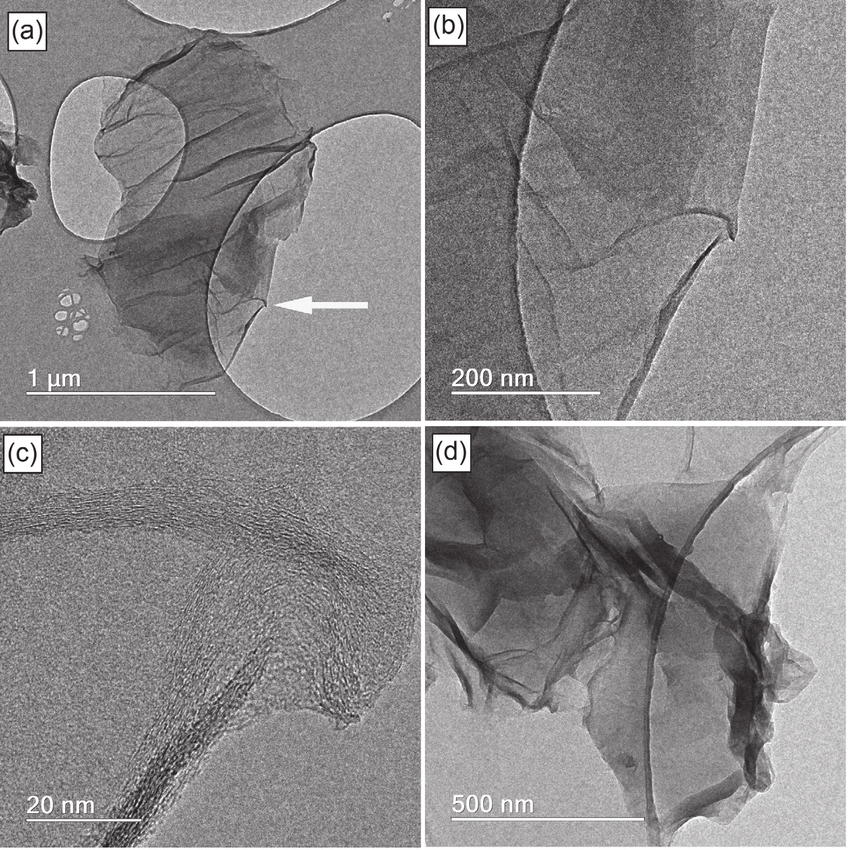
|
Thin graphene oxide sheets can translocate from the nasal cavity to the brain
Translocation is size dependent, with ultrasmall nanometric sheets translocating the most
Kinetics of graphene oxide accumulation are time dependent and brain-region-specific
Brain-accumulated graphene oxide undergoes changes consistent with biodegradation
Article
Nose-to-Brain Translocation and Cerebral Biodegradation of Thin Graphene Oxide NanosheetsLeon Newman,1,2
Artur Filipe Rodrigues,1,2Dhifaf A. Jasim,1,2Isabella Anna Vacchi,3Cecilia Meard-Moyon,3Alberto Bianco,3,6Cyrill Bussy,1,2,*and Kostas Kostarelos1,2,4,5,7,*
SUMMARY
Understanding the interactions of graphene oxide (GO)-basedmaterials with biological systems is critical due to the potentialapplications of these materials. Here, we investigate the extent towhich single- to few-layer GO sheets of different controlled lateraldimensions translocate from the nose to the brain following intra-nasal instillation. We explore tissue location andin vivobiodegrad-ability of the translocated materials using various techniques. Massspectrometry and confocal Raman analyses indicate that traceamounts of GO undergo nose-to-brain translocation in a size-depen-dent manner. The smallest GO-sheet size category (us-GO, 10-550 nm) gains the greatest access to the brain in terms of quantity
|
|
Graphene Oxide Poisoning is Covid 19
The introduction of graphene oxide in; ppe equipment, masks, covid tests, covid vaccines leads the belief that it indeed could intentionally be the cause of the supposed scamdemic. Graphene Oxide poisoning causes the same symptoms of covid 19. Lung damage, blood clotting, loss of taste and smell and explain why many people which have recieved the covid vax report magnetism to metallic objects at the site of injection.
I stumbled upon the research done by spanish researchers from la quinta columna https://stateofthenation.co/?p=70400
Graphene oxide would have been introduced in high amounts in flu shots prior to 2020 which would have been taken by the elderly, for the most part. This explains why the elderly are more affected. Graphene oxide can be eliminated naturally by our bodies by glutathione, a powerful antioxidant which already decreases as we age. The younger one is, the higher the amounts of glutathione. It is also produced in great amounts during exercise which is why athletes have not been affected by covid and in most cases have had no symptoms. This is also why i believe the strict lockdowns were implemented which prevented many people from exercising and naturally producing glutathione. Yes many exercised outside, but many also previously relied on a gym to exercise and once those were closed they didn't exercise anymore.
Taking N-acetyl cysteine (NAC) is the best way to dramatically increase glutathione. It is sold as a supplement. It is used in cough medicine as it is also effective in devreasing mucus along with its antioxidant properties and liver detoxification. The FDA is now in the process of banning NAC as a supplement and the timing is perfect. It expressed the intent to ban the substance in 2020, perfectly timed with the breakout of covid 19.
https://fda.news/2020-08-21-fda-trying-make-n-acetylcysteine-illegal-could-help-treat-covid19.html#
Although i still found NAC on amazon it is now unavailable on myprotein where i had previously purchased it and many brands are now even disappearing from amazon.
I also found this study
https://pubmed.ncbi.nlm.nih.gov/30218681/ which indicates that graphene oxide inhibits spermatogenisis among other things. Depopulation. The spanish researchers also indicate the danger of having graphene oxide when the 5g network will be activated, lending to the idea of another 'pandemic' in a few years time when the grid will be activated and established. It essentially causes the famous cytokine storm you probably already heard about and basically makes the immune system useless. This time round deaths will be tremendous. This coincides with the Rockefeller foundation's 'Operation Lockstep' which has laid out the plan for what we see is happening currently. After the initial pandemic there would be a secondary one in which approximately 30% of people worldwide would die.
Fun fact: the first province where 5g was rolled out was in Wuhan.
Google 'graphene oxide covid19" and all you find are articles and studies promoting the nanoparticle and how it can help by being introduced in screening and vaccine. Red flag.
https://pubmed.ncbi.nlm.nih.gov/32382315/
https://www.graphene-info.com/how-can-graphene-assist-war-coronavirus
The booster shots every year or multiple times a year would guarantee a high level of graphene oxide in the body and would not allow enough time for natural excretion of the nanoparticle by the body through antioxidative pathways. It is important to add that graphene oxide is present in all current vaccines, nasal spray vaccines and flu shots. So best bet is to forget about getting any kind of vaccination from now on.
|
|
|
|
Pulsed-Electromagnetic-Field-Assisted Reduced Graphene Oxide Substrates for Multidifferentiation of Human Mesenchymal Stem Cells
Electromagnetic fields (EMFs) can modulate cell proliferation, DNA replication, wound healing, cytokine expression, and the differentiation of mesenchymal stem cells (MSCs). Graphene, a 2D crystal of sp(2) -hybridized carbon atoms, has entered the spotlight in cell and tissue engineering research. However, a combination of graphene and EMFs has never been applied in tissue engineering. This study combines reduced graphene oxide (RGO) and pulsed EMFs (PEMFs) on the osteogenesis and neurogenesis of MSCs. First, the chemical properties of RGO are measured. After evaluation, the RGO is adsorbed onto glass, and its morphological and electrical properties are investigated. Next, an in vitro study is conducted using human alveolar bone marrow stem cells (hABMSCs). Their cell viability, cell adhesion, and extracellular matrix (ECM) formation are increased by RGO and PEMFs. The combination of RGO and PEMFs enhances osteogenic differentiation. Together, RGO and PEMFs enhance the neurogenic and adipogenic differentiation of hABMSCs. Moreover, in a DNA microarray analysis, the combination of RGO and PEMFs synergically increases ECM formation, membrane proteins, and metabolism. The combination of RGO and PEMFs is expected to be an efficient platform for stem cell and tissue engineering.
National Institute of Health/Pub Med
|
Graphene Oxide in Vaccines?
|
La Quinta Columna made an urgent announcement that they hope will reach as many people as possible, especially those involved in health and legal services, as biostatistician Ricardo Delgado, Dr. Jose Luis Sevillano and the team of researchers and professors with whom they have been conducting their research have confirmed the presence of graphene oxide nanoparticles in vaccination vials.
In program no.63, the team showed some photos of the analyses carried out, specifically results obtained by optical and transmission electron microscopy observation, reserving the results of other techniques used for future programs. They also announced that the report based on all the techniques performed, which allowed determining the presence of graphene oxide, will be made official by the researchers who performed the analyses very soon.
Orwell City translated the message from La Quinta Columna and subtitled the video.
CRITICAL THINKING ALERT!
study refuted by Whitney Webb finds odditys in the paper making the claim.
see this 2021 report -
DETECTION OF GRAPHENE IN COVID19 VACCINES BY MICRO-RAMAN SPECTROSCOPY - Prof. Dr. Pablo Campra Madrid ASSOCIATE UNIVERSITY PROFESSOR PhD in Chemical Sciences Degree in Biological Sciences
full access to latest reports from Laquinta Column
|

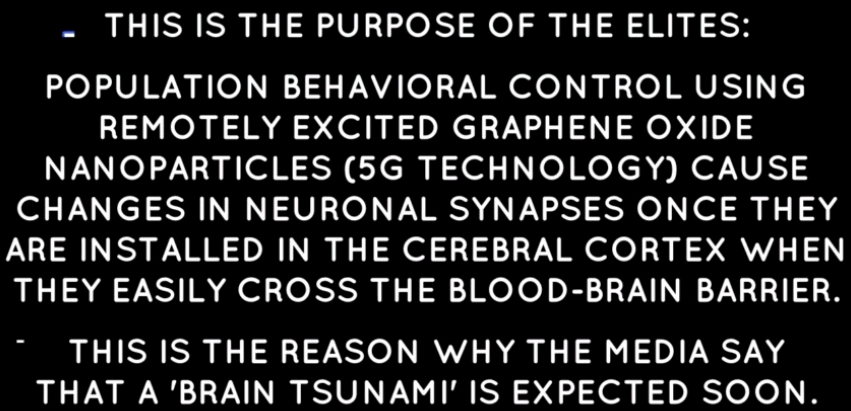
|
|
see pdf file for screenshots of strange objects in vaccines compared to the slideshow of a presentation by Dr lovely - of bio-nano machinery
"Protein nanowires for sensing, energy harvesting & wiring cells to electronics"
|
|

|
now watch this: the following video proports to show A Hacker backdooring into Russian Sputnik MRNA database
He then finds real time tracking database tracking people via whats now in their bodies after the vaccine.
|
Brain Tsunamis

|
Scientists have detected 'brain tsunamis' in human beings that cause irreversible damage to the organ.
These neurological events occur several days after severe head trauma and may be responsible for inducing brain damage, according to a new study published in the 'Annals of Neurology.'
In the study, researchers provide insight into the neurobiology of dying. It sheds light on how these tsunamis or "killer waves" could help patients with severe head trauma avoid further brain damage and possibly retain most of their brain function.
The "brain tsunamis" are actually a large population of brain cells that undergo massive depolarisations. Much like the weather-related tsunamis, these large waves of depolarisations spread slowly but persistently throughout the brain, causing widespread brain dysfunction.
These wave-like depolarisations have been studied in brain trauma patients for decades. But the new research showed for the first time that brain tsunamis are responsible for causing further brain damage in afflicted patients.
For the study, investigators performed continuous patient monitoring following 'Do Not Resuscitate-Comfort Care' orders in patients with devastating brain injury to investigate the mechanisms and timing of events in the brain and the circulation during the dying process.
The findings may be helpful for developing treatment strategies of cardiac arrest and stroke that may complement efforts to re-establish circulation, and also inform the debate of organ donation after cardio-circulatory death, where death is declared between two and ten minutes following the cessation of circulatory function.
"After circulatory arrest, spreading depolarisation marks the loss of stored electrochemical energy in brain cells and the onset of toxic processes that eventually lead to death. Importantly, it is reversible, up to a point, when the circulation is restored," said lead author Dr. Jens Dreier, of Universitätsmedizin Berlin, in Germany.
"There are no direct implications for patient care today. Particular challenges include the slowness of this wave that hampers its visibility in normal EEG recordings; however, this discovery may lead to improved diagnostic and treatment procedures in the future, following Max Planck's motto that 'insight must precede application'."
The brain tsunamis drew the attention of the US military as head injuries became a very common injury among veterans of the Iraq and Afghanistan wars.
(With inputs from agencies) source
|
Brain states: recorded to create a brain activity 'fingerprint.'
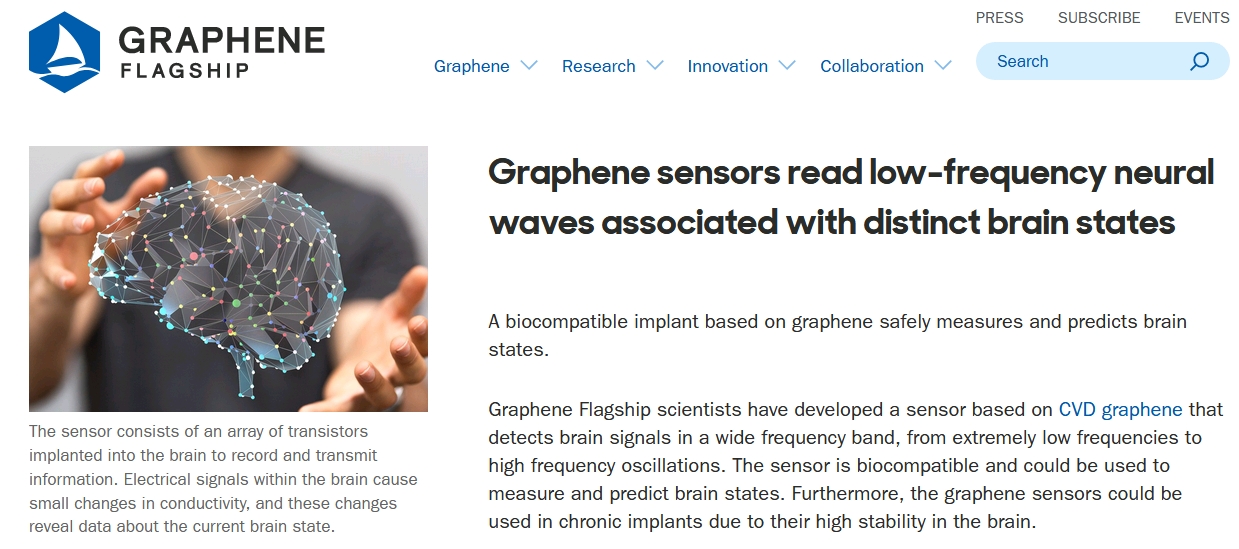
|
The study was conducted by scientists at Graphene Flagship partners the Catalan Institute of Nanoscience and Nanotechnology (ICN2), the Microelectronics Institute of Barcelona (CSIC), CIBER-BBN and ICREA, Spain, Ludwig-Maximilians University, Germany, and the University of Manchester, UK, in collaboration with Graphene Flagship partner Multi Channel Systems GmbH, Germany.
The consortium showed that graphene-based sensors grant access to an elusive low-frequency region of brain activity. Current methods to detect brain waves use metallic electrodes, which are ineffective at measuring very low-frequency activity " known as the "˜infra-slow' region. Thanks to graphene's sensitivity, scientists can now easily gather information from this region and paint a better picture of animals' brain activity. This could form the basis for new types of neurotherapeutic medical technology.
Using a technology developed by ICN2 and the Microelectronics Institute of Barcelona, in the framework of the Graphene Flagship and the BrainCom European projects, Graphene Flagship scientists built an array of transistors that record and transmit activity information when implanted into the brain. The sensor has small channels on the surface: when they make contact with brain tissue, the electrical signals within the brain cause small changes in conductivity. These changes produce a signal and are recorded to create a brain activity "˜fingerprint.'
"With our array of devices, based on CVD graphene, we can record signals from the infra-slow region with very high accuracy," Jose Garrido, from Graphene Flagship partner ICN2, Spain, explains. "In the brain, there is a correlation between lower and higher frequencies of brain activity, so the lower frequencies tend to dictate what the higher frequencies look like. We demonstrated that, by measuring the infra-slow activity, with frequencies below a tenth of a hertz, we can decode the "˜brain states' of an animal." Garrido believes this technology could lead to new treatments for brain disorders like epilepsy, as certain characteristic signal patterns could reveal "˜brain states' likely to lead to seizures.
To test the device, they implanted it into the brain of a freely behaving rat, monitoring it continuously. The signals were transmitted wirelessly using a miniaturized electronic headstage developed by the industrial partner Multichannel Systems. The scientists found that the signal characteristics measured during different types of brain activity, such as during periods of high activity or during sleep " the so-called "˜brain states' " correlated very well to the infra-slow signals decoded by the graphene-based implant.
Furthermore, Kostas Kostarelos and colleagues at Graphene Flagship partner the University of Manchester, UK, tested the biocompatibility of the devices. They found no inflammation, other than that expected to occur from the device's implantation, over the entire 12-week duration of their tests, and the device did not degrade over this period.
"It is very remarkable to see that we can properly identify and correlate the animals' brain states with the measured infra-slow activity," Garrido says. Now, the next step will be to explore commercial applications. "We are already collaborating with some companies interested in this technology, and we aim to translate it into a product " and, beyond that, take it into clinics and hospitals," he concludes.
Serge Picaud, Deputy Leader of the Graphene Flagship's Biomedical Technologies Work Package, comments: "Novel technologies are always a vector for new discoveries. In this case, graphene sensors have granted us access to the infra-slow brain waves. Recording them in animal models and patients will demonstrate whether we can actually rely on these new measurements for precise diagnostics and treatment options in patients with serious brain diseases like epilepsy."
Andrea C. Ferrari, Science and Technology Officer of the Graphene Flagship and Chair of its Management panel, adds: "The Graphene Flagship recognised the potential of graphene and layered materials for biological applications early on. This remarkable work brings us closer to applications in this area, with a novel tool enabled by the unique properties of graphene."
source
|
|
Graphene Flagship spin-off INBRAIN raises investment of over (Eu)14M
INBRAIN Neuroelectronics is bringing a complete technological transformation to the treatment of neurological diseases. Its brain implantable intelligent systems are based on graphene electrodes, which allow miniaturisation to nanoscale fabrication, with the potential to reach single-neuron resolution. The extraordinary properties of graphene ? which is light, biocompatible, flexible and extremely conductive ? are harnessed in much smaller devices that are safer to implant and can be programmed, upgraded and recharged wirelessly.
Driven by artificial intelligence, the implant can learn from the brain of each specific patient and trigger adaptive responses to deliver personalised neurological therapy. In addition, the use of big data management will permit remote monitoring of the device and data processing.
|
INBRAIN Neuroelectronics S.L. is a medical device company dedicated to the development and commercialization of graphene-based neural interfaces and intelligent neuromodulation systems.
"Bioelectronic devices have the capability to directly communicate with the nervous system. Recording nerve signals and combining them with other accessible physiological datasets will lead to a better understanding of disease conditions and enable personalized treatment regimens," said Robert Spoelgen, Head of Bioelectronics, Merck Innovation Center. "We are convinced that bioelectronic devices will play a significant role in the future therapeutic landscape."
|
SOMA type stress relief?
Engineered small graphene oxide (s-GO) sheets were previously shown to reversibly down-regulate glutamatergic synapses in the hippocampus of juvenile rats, disclosing an unexpected translational potential of these nanomaterials to target selective synapses in vivo.
Synapses are anatomical specializations acting in the Central Nervous System (CNS) as functional interfaces among neurons. Dynamic changes in synaptic function, named synaptic plasticity, are crucial to learning and memory. More recently, pathological mechanisms involving dysfunctional synaptic plasticity were implicated in several brain diseases, from dementia to anxiety disorders.
Hyper-excitability of glutamatergic neurons in the lateral nucleus of the amygdala complex (LA) is substantially involved in the storage of aversive memory induced by stressful events enabling post-traumatic stress disorder (PTSD).
Here we translated in PTSD animal model the ability of s-GO, when stereotaxically administered to hamper LA glutamatergic transmission and to prevent the behavioral response featured in long-term aversive memory. We propose that s-GO, by interference with glutamatergic plasticity, impair LA-dependent memory retrieval related to PTSD.
Graphene oxide prevents lateral amygdala dysfunctional synaptic plasticity and reverts long lasting anxiety behavior in rats
see also -
Wake Up Dopey
|
|
"Two days after injecting graphene oxide into a specific region of the mouse's brain, it behaved like other mice that had never experienced the smell of a cat in their home environment. In other words, graphene oxide inhibited the mouse's anxiety-related behaviour," Ballerini explains. She says that two days is roughly the time for memories to form and be consolidated in the mouse's brain, which corresponds to the time for the symptoms of anxiety to subside.
"Graphene oxide interacts with the part of the brain responsible for the formation of fear-related memories, which cause anxiety. It doesn't work like a drug, by inhibiting the function of the receptors " instead, it temporarily halts the entire mechanism long enough to disrupt the brain's fear-related pathology, without damaging them," continues Ballerini.
Graphene oxide interrupts anxiety-related neuron signals without affecting the neurons, or the surrounding cells. In simple terms, it only "˜turns down' the communications between specific neurons. In a disease where these communications are over-expressed, like PTSD and anxiety, targeting the synapses with graphene oxide is enough to halt the development of this pathological behaviour. This is a type of precision medicine."
|
|
Magnetic resonance imaging (MRI)
compatible neural electrodes are important for combining high-resolution electrophysiological measurements with more global MRI mapping of brain activity, which is critical for fundamental neuroscience studies, as well as clinical evaluation and monitoring.
Copper is a favorable material to use in MRI because it has magnetic susceptibility close to water and tissues. However, the cytotoxicity of copper precludes its direct implantation for neural recording.
Here, we overcome this limitation by developing a graphene encapsulated copper (G-Cu) microelectrode. The toxicity of copper is largely eliminated, as evidenced by the in vitro cell tests and in vivo histology studies.
Local field potentials and single-unit spikes were recorded from rodent brains with the G-Cu microelectrodes. Notably, the G-Cu microelectrodes show no image artifacts in a 7.0 T MRI scanner, indicating minimal magnetic field distortion in their vicinity.
This high MRI compatibility of our G-Cu probes would open up new opportunities for fundamental brain activity studies and clinical applications requiring continuous MRI and electrophysiological recordings.
|
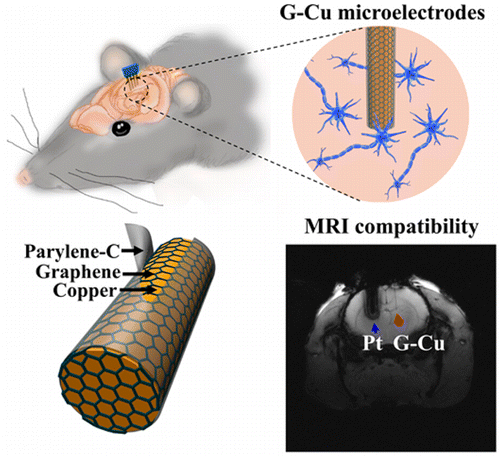
|
Graphene electrodes & (F)Magnetic resonance Imaging
"The GF electrodes caused minimal interference to the magnetic field, and their presence would not cause significant attenuation in fMRI signals, thus enabling a full and unbiased mapping of the activation pattern under DBS–fMRI studies,” write the researchers. “Such advantage is critical for exploring the neuromodulatory effects and mechanisms of DBS therapies.”
"With the unique capability for full and unbiased mapping of the entire circuit and network connectivity without obstructing brain nuclei, future DBS–studies with the GF electrodes at different targets and with varied stimulation frequency and strength could provide important insights into brain circuitries and network connections, as well as the therapeutic mechanisms underlying various DBS therapies,"

Control of Mind using Nanotechnology
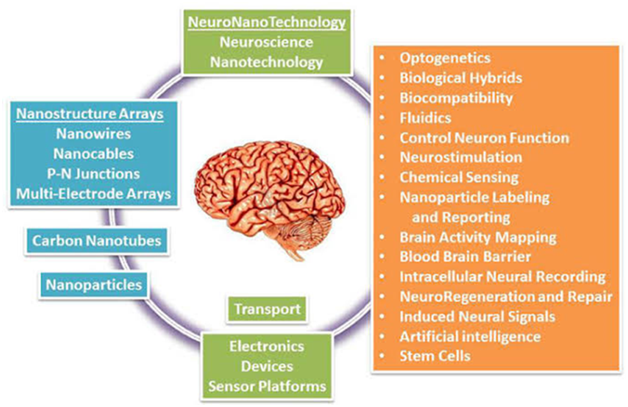 click on pic for source |
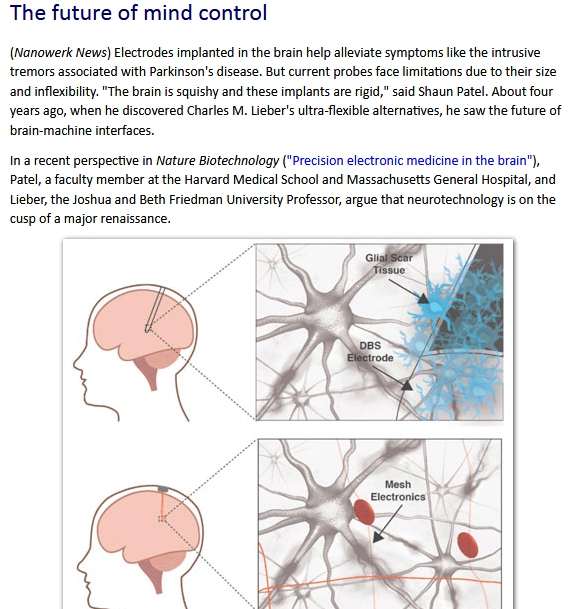 click on pic for source |
SUZANNE GILDERT HAS A PROBLEM -
SHE KEEPS DREAMING SHE IS THE
SELF MANUFACTURED ROBOT VERSION OF HERSELF!
|
Suzanne Gildert
is currently a founder and CTO of Sanctuary AI.
Prior to founding Sanctuary, Suzanne founded Kindred, an artificial intelligence and robotics company. She hand built over 30 robots to demonstrate Kindred's core technology concept of human robot tele-operation for reinforcement learning.
She grew the company to over 50 employees and opened offices in Vancouver, Toronto, and San Mateo. She helped raise over $50M in venture funding for Kindred from top tier investors including Eclipse, Google Ventures, First Round Capital and Data Collective.
Suzanne also worked for D-Wave, a Canadian company pioneering quantum computing technology.
In 2011, Suzanne joined D-Wave's machine learning group. In this role she invented and coded most of the use cases D-Wave produced in the period 2011-2013, including MAXCAT, the world's first quantum computer game, and the world's first control of a robot by a quantum computer. She also worked on the world's first supervised binary classifier run on a quantum computer. Her work has been published in several scientific peer reviewed journals, including Nature magazine, and she holds five patents.
She led the quantum computing training programs for Lockheed Martin, Google and NASA.
|
She designed, coded and ran the company's Developer Portal and the company website. Prior to joining D-Wave, Suzanne worked at the University of Birmingham, UK, where she earned a PhD in Physics and Electronics and subsequently undertook a postdoctoral role. The role focused on cutting edge research with superconducting devices at ultra-low temperatures, giving her a wealth of experience in the design, fabrication and debugging of complex hardware systems. She has worked with hardware at all scales, from microscopic devices up to large, heavy-duty industrial machinery.
Suzanne is also a published digital artist and poet, has worked as a graphic designer, and pioneered a technique for creating art using a quantum computer. She loves painting using acrylic on canvas, mixed media, digital painting, tapestry, and she also creates electronic music (synthesizer / keyboard / piano) inspired by retro video games and the synthwave genre.
BIO
Why would someone who makes robots be an expert in Quantum Computing?
|
|
The mind of a robot? "Spintronics devices are promising for future energy-efficient and adoptive computing systems, as they behave like neurons and synapses in the human brain." |
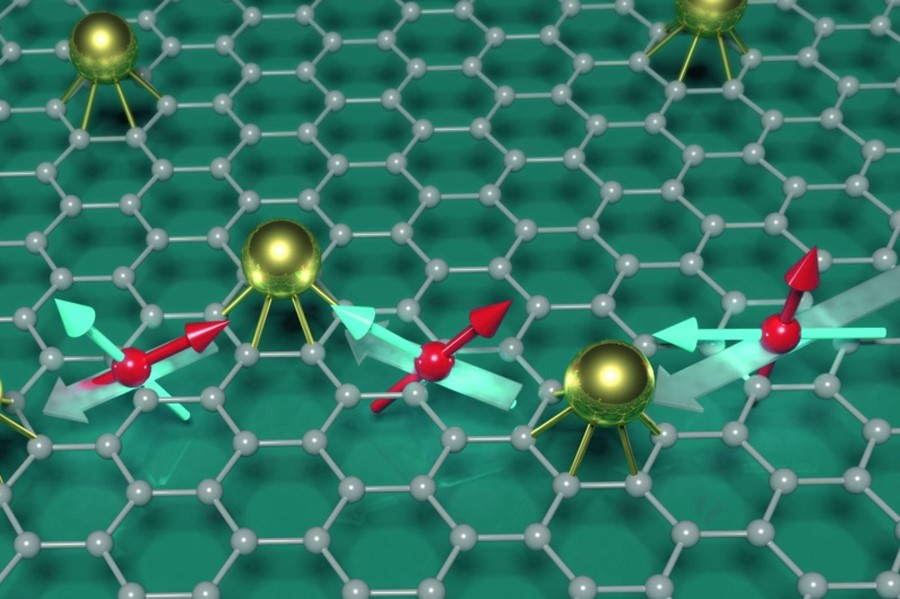 |
|
|
|
|
|
|
|
Graphene - Wireless and Satellite
New graphene optoelectronic mixers boost high speed Telecommunications
"The photomixing technique developed in this work is a high impact technology for broad range of applications, such as generation of millimetre waves for future wireless systems and radars, or for ultra-stable frequency generation in all radio systems. In this high impact technology, graphene plays an important role. Thanks to its ultrafast nature, it enables all range of high frequencies and, thanks to its high electrooptical efficiency, graphene generates high frequency electromagnetic waves with unprecedented conversion efficiency that, with further developments, could state new records in performance."
Andrea C. Ferrari, Science and Technology Officer of the Graphene Flagship and Chair of its Management Panel, adds: "We are at the verge of the integration of graphene-based optolectronics into commercial devices. This work, spearheaded by the leading EU Graphene Flagship partner company Thales, shows the industry push for the technology. Our ambition is to see future 5G and 6G devices integrating graphene and layered materials technologies, enabling higher efficiency, speed, and lower power consumption."
new-graphene-optoelectronic-mixers-boost-high-speed-telecommunications
|
|
Mitre=MIT - SAGE radar system
The MITRE Corporation was chartered in 1958 as a private, not-for-profit company to provide engineering and technical guidance for the federal government. Since then, MITRE has operated at the intersection of advanced technology and vital national concerns. We've grown to serve a variety of government agencies at the highest levels through the operation of federally funded research and development centers (FFRDCs).
The company's initial focus was on the continental air defense project called the Semi-Automated Ground Environment (SAGE). SAGE relied on the first digital computers to link radar stations, weapons systems, and military decision makers in near real time.
SAGE became operational in 1963. It spawned numerous innovations in computing, software, information displays, communications, program management, and systems engineering. To name a few: the National Airspace System, Airborne Warning and Communications Systems (AWACS), Joint Tactical Information Distribution System (JTIDS), and Joint Surveillance Target Attack Radar System (Joint STARS).
relied on the first digital computers to link radar stations, weapons systems, and military decision makers in near real time.
MITRE's roots began in the computer laboratories of the Massachusetts Institute of Technology (MIT) during World War II. Throughout the 1940s and early 1950s, MIT's scientists developed the first large-scale digital computer, dubbed Whirlwind I. A group of engineers working at MIT Lincoln Laboratory's Division 6 continued to expand its capabilities.
|
 Note the acronym - "SAGE"
|

|
From the Mitre Corporation
MATTER AS SOFTWARE
James C. Ellenbogen, Ph.D.The MITRE Corporation
ABSTRACT
In the next century, as the components of computers continue to shrink smaller and smaller,down to the molecular scale, their physical representation will become more and more like that ofpresent-day computer data.
It is explained in some detail how this ongoing process ofminiaturization is likely to lead to a technology in which matter will acquire desirable physical andeconomic properties much like those of software.
It will be possible to "read" and to "write" functioning computer components and logic structures at will; they will be manufactured locally,on demand, in a manner similar to the way we now "download" software onto disk drives.
In addition, microscopic and submicroscopic mutable computer logic structures will be built intomotile microscopic units of matter, putting the macroscopic properties, form, and function ofmatter itself under program control.
Thus, in the next century, the technology developed forbuilding dramatically smaller computational engines will evolve to have even broader technological and economic impacts than have been felt during the last half century of the digital computer revolution.
|
|
|
Molecular nanotechnology is the physical underpinning for the singularity |
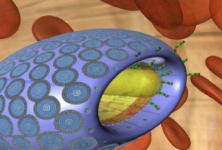
Ray Kurtzweil 2010 reviews his predictions - |
Nanofactory
Our nanofactory will be constructed from diamondoid components of the same sort that it can itself manufacture. While molecular manufacturing systems made from DNA, other biopolymers, or even biological organisms are possible, such systems would be unable to build products that approach the remarkable strength, stiffness, temperature range, lightness, electrical, optical and other properties that can achieved with diamondoid materials.
and
The killer app for digital fabrication is personal fabrication - things you can't buy at Walmart. What if, instead of sending energy, computation, etc. around the world, we sent the means to create it? As regular objects become computerized and interconnected at a smaller and smaller scale, we're approaching the nano-scale of biological systems. We're on the cusp of a fabrication revolution.
- Neil Gershenfeld, Director of the Center for Bits and Atoms at MIT, in his SC07 keynote address on 13 November 2007.
|
will it become a planetary hard drive?
as molecular data storage?
|
|
Progress on molecular data storage system
Date: February 4, 2020
A team of Brown University researchers has made substantial progress in an effort to create a new type of molecular data storage system.
In a study published in Nature Communications, the team stored a variety of image files -- a Picasso drawing, an image of the Egyptian god Anubis and others -- in arrays of mixtures containing custom-synthesized small molecules. In all, the researchers stored more than 200 kilobytes of data, which they say is the most stored to date using small molecules. That's not a lot of data compared to traditional means of storage, but it is significant progress in terms of small molecule storage, the researchers say.
"I think this is a substantial step forward," said Jacob Rosenstein, an assistant professor in Brown's School of Engineering and an author of the study. "The large numbers of unique small molecules, the amount of data we can store, and the reliability of the data readout shows real promise for scaling this up even further."
As the data universe continues to expand, much work is being done to find new and more compact means of storage. By encoding data in molecules, it may be possible to store the equivalent of terabytes of data in just a few millimeters of space. Most research on molecular storage has focused on long-chain polymers like DNA, which are well known carriers of biological data. But there are potential advantages to using small molecules as opposed to long polymers. Small molecules are potentially easier and cheaper to produce than synthetic DNA, and in theory have an even higher storage capacity.
|
|
The Brown research team, supported by a U.S. Defense Advanced Research Projects Agency (DARPA) grant led by chemistry professor Brenda Rubenstein, has been working to find ways of making small-molecule data storage feasible and scalable.
To store data, the team uses small metal plates arrayed with 1,500 tiny spots less than a millimeter in diameter. Each spot contains a mixture of molecules. The presence or absence of different molecules in each mixture indicate the digital data. The number of bits in each mixture can be as large as the library of distinct molecules available for mixing. The data can then be read out using a mass spectrometer, which can identify the molecules present in each well.
In a paper published last year, the Brown team showed that they could store image files in the kilobyte range using some common metabolites, the molecules that organisms use to regulate metabolism. For this new work, the researchers were able to vastly expand the size of their library -- and thereby the sizes of the files they could encode -- by synthesizing their own molecules.
The team made their molecules using Ugi reactions -- a technique often used in the pharmaceutical industry to quickly produce large numbers of different compounds. Ugi reactions combine four broad classes of reagents (an amine, an aldehyde or a ketone, a carboxylic acid, and an isocyanide) into one new molecule. By using different reagents from each class, the researchers could quickly produce a wide array of distinct molecules. For this work, the team used five different amines, five aldehydes, 12 carboxylic acids, and five isocyanides in different combinations to create 1,500 distinct compounds.
"The advantage here is the potential scalability of the library," Rubenstein said. "We use just 27 different components to make a 1,500-molecule library in one day. That means we don't have to go out and find 1,500 unique molecules."
From there, the team used sub-libraries of compounds to encode their images. A 32-compound library was used to store a binary image of the Egyptian god Anubis. A 575-compound library was used to encode a 0.88-megapixel Picasso drawing of a violin.
The large number of molecules available for the chemical libraries also enabled the researchers to explore alternate encoding schemes that made the readout of data more robust. While mass spectrometry is highly precise, it's not perfect. So as with any system used to store or transmit data, this system will need some form of error correction.
"The way we design the libraries and read out the data includes extra information that lets us correct some errors," said Brown graduate student Chris Arcadia, first author of the paper. "That helped us streamline the experimental workflow and still get accuracy rates as high as 99 percent."
There's still more work to be done to bring this idea up to a useful scale, the researchers say. But the ability to create large chemical libraries and use them for encoding ever larger files suggests the approach can indeed be scaled up.
"We're no longer limited by the size of our chemical library, which is really important," Rosenstein said. "That's the biggest step forward here. When we started this project a few years ago, we had some debates about whether something of this scale was even experimentally feasible. So it's really encouraging that we've been able to do this."
Other co-authors on the paper were Eamonn Kennedy, Joseph Geiser, Amanda Dombroski, Kady Oakley, Shui-Ling Chen, Leonard Sprague, Mustafa Ozmen, Jason Sello, Peter M. Weber, Sherief Reda, Christopher Rose and Eunsuk Kim. The work was funded by DARPA (W911NF-18-2-0031) and the National Science Foundation (1941344).
|
|
|
|
big brother on steroids Be seeing you... forget spying on you They want to spy through you July 2021
|